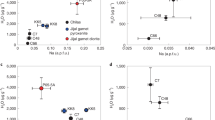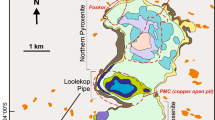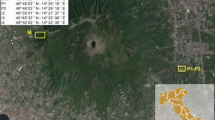Abstract
Apatite phenocrysts from the 1963 and 1723 eruptions of Irazú volcano (Costa Rica) record a volatile evolution history that confirms previous melt inclusion studies, and provides additional information concerning the relative and absolute timing of subvolcanic magmatic events. Measurements of H, Cl, and F by secondary ion mass spectrometry reveal multiple populations of apatite in both 1723 and 1963 magmas. Assuming nominal apatite/melt partition coefficients allows us to compare the pattern of melt inclusions and apatites in ternary space, demonstrating the fidelity of the record preserved in apatite, and revealing a complex history of magma mixing with at least two components. The preservation of heterogeneous populations of apatite and of internally heterogeneous crystals requires short timescales (days to years) for these magmatic processes to occur.






Similar content being viewed by others
References
Alvarado G (1993) Volcanology and petrology of Irazú Volcano. Costa Rica. Ph.D. thesis, Christian-Albrechts Universität zu Kiel, Kiel, p 261
Alvarado G, Carr MJ, Turrin BD, Swisher CC III, Schmincke H-U, Hudnut KW (2006) Recent volcanic history of Irazú volcano, Costa Rica: alternation and mixing of two magma batches, and pervasive mixing. In: Rose WI, Bluth GJS, Carr MJ, Ewert J, Patino LC, Vallance J (eds) Volcanic hazards in Central America, vol 412, pp 259–276
Anderson AT (1974) Evidence for a picritic, volatile-rich magma beneath Mt. Shasta, California. J Petrol 15:243–267
Benjamin E, Plank T, Wade J, Kelley K, Hauri E, Alvarado G (2007) High water contents in basaltic magmas from Irazú Volcano, Costa Rica. J Volcanol Geotherm Res 168:25
Boyce J, Hervig R (2008) Magmatic degassing histories from apatite volatile stratigraphy. Geology 36(1):63. doi:10.1130/G24184A.1
Brenan J (1993) Kinetics of fluorine, chlorine, and hydroxyl exchange in fluorapatite. Chem Geol 110:195–210. doi:10.1016/0009-2541(93)90254-G
Clark SK, Reagan MK, Plank T (1998) Trace element and U-series systematics for 1963–1965 tephras from Irazú Volcano, Costa Rica: Implications for magma generation processes and transit times. Geochim Cosmochim Acta 62:2689–2699. doi:10.1016/S0016-7037(98)00179-3
Danyushevsky LV, McNeill AW, Sobolev AV (2002) Experimental and petrological studies of melt inclusions in phenocrysts from mantle-derived magmas; an overview of techniques, advantages, and complications. Chem Geol 183(1–4):5–24. doi:10.1016/S0009-2541(01)00369-2
Farley KA, Stockli D (2002) (U-Th)/He dating of phosphates: apatite, monazite, and xenotime. Rev Mineral Geochem 48:559–577
Gleadow AGW, Belton DX, Kohn BP, Brown RW (2002) Fission track dating of phosphate minerals and the thermochronology of apatite. Rev Mineral Geochem 48:579–630
Hovis G, Harlov D, Hahn A, Seigert H (2007) Enthalpies and volumes of F-Cl mixing in fluorapatite–chlorapatite crystalline solutions: Geophys Res Abstr 9:01748
John T, Klemd R, Gao J, Garbe-Schönberg C-D (2008) Trace-element mobilization in slabs due to non steady-state fluid–rock interaction: constraints from an eclogite-facies transport vein in blueschist (Tianshan, China). Lithos 103:1–24
Mathez E, Webster J (2005) Partitioning behavior of chlorine and fluorine in the system apatite-silicate melt-fluid. Geochim Cosmochim Acta 69(5):1275–1286. doi:10.1016/j.gca.2004.08.035
Nadeau SL, Epstein S, Stolper E (1999) Hydrogen and carbon abundances and isotopic ratios in apatite from alkaline intrusives, with a focus on carbonatites. Geochim Cosmochim Acta 63(11–12):1837–1851. doi:10.1016/S0016-7037(99)00057-5
Newman S, Lowenstern JB (2002) VolatileCalc: a silicate melt-H2O-CO2 solution model written in Visual Basic for Excel. Comput Geosci 28:597–604. doi:10.1016/S0098-3004(01)00081-4
Pan YM, Fleet ME (2002) Compositions of the apatite-group minerals: substitution mechanisms and controlling factors. Rev Mineral Geochem 48:13–49
Papale P, Moretti R, Barbato D (2006) The compositional dependence of the saturation surface of H2O + CO2 fluids in silicate melts. Chem Geol 229(1–3):78–95. doi:10.1016/j.chemgeo.2006.01.013
Parat F, Holtz F (2004) Sulfur partitioning between apatite and melt and effect of sulfur on apatite solubility at oxidizing conditions. Contrib Mineral Petrol 147:201–212. doi:10.1007/s00410-004-0553-7
Peng G, Luhr JF, McGee JJ (1997) Factors controlling sulfur concentrations in volcanic apatite. Am Mineral 82:1210–1224
Piccoli P, Candela P (1994) Apatite in felsic rocks: a model for the estimation of initial halogen concentrations in the Bishop Tuff (Long Valley) and Tuolumne intrusive suite (Sierra Nevada batholith) magmas. AJS 294:92–135
Pyle JM, Spear FS, Rudnick RL, McDonough WF (2001) Monazite-xenotime-garnet equilibrium in metapelites and a new monazite-garnet thermometer. J Petrol 42:2083–2107. doi:10.1093/petrology/42.11.2083
Sadofsky S, Portnyagin M, Hoernle K, Bogaard P (2008) Subduction cycling of volatiles and trace elements through the Central American volcanic arc: evidence from melt inclusions. Contrib Mineral Petrol 155(4):433–456. doi:10.1007/s00410-007-0251-3
Schoene B, Bowring S (2007) Determining accurate temperature—time paths from U–Pb thermochronology: an example from the Kaapvaal craton, southern Africa. Geochim Cosmochim Acta 71(1):165–185. doi:10.1016/j.gca.2006.08.029
Spear FS, Pyle JM (2002) Apatite, monazite, and xenotime in metamorphic rocks. Rev Mineral Geochem 48:293–335
Streck MJ, Dilles JH (1998) Sulfur evolution of oxidized arc magmas as recorded in apatite from a porphyry copper batholith. Geology 26:523–526. doi:10.1130/0091-7613(1998)026<0523:SEOOAM>2.3.CO;2
Acknowledgments
This project was funded by a National Science Foundation MARGINS program Postdoctoral Fellowship (NSF-EAR-0549082). The SIMS laboratory at Arizona State University is funded by NSF EAR 0622775. Samples were generously provided by T. Plank, and collected by E. Benjamin. Apatites used as standards were provided by J. Hanchar, and S. Bergman. Many people contributed to this project via hearty discussion, including attendees of the SEIZE-SubFac Workshop 2007, and petrologists at ASU and UCLA. The article benefited from constructive criticism from J. Wade, G. Moore, M. Portnyagin, and an anonymous reviewer, and we thank them for their efforts.
Author information
Authors and Affiliations
Corresponding author
Additional information
Communicated by J. Hoefs.
Rights and permissions
About this article
Cite this article
Boyce, J.W., Hervig, R.L. Apatite as a monitor of late-stage magmatic processes at Volcán Irazú, Costa Rica. Contrib Mineral Petrol 157, 135–145 (2009). https://doi.org/10.1007/s00410-008-0325-x
Received:
Accepted:
Published:
Issue Date:
DOI: https://doi.org/10.1007/s00410-008-0325-x




